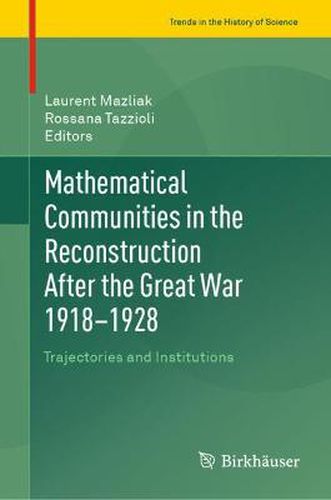Readings Newsletter
Become a Readings Member to make your shopping experience even easier.
Sign in or sign up for free!
You’re not far away from qualifying for FREE standard shipping within Australia
You’ve qualified for FREE standard shipping within Australia
The cart is loading…






This title is printed to order. This book may have been self-published. If so, we cannot guarantee the quality of the content. In the main most books will have gone through the editing process however some may not. We therefore suggest that you be aware of this before ordering this book. If in doubt check either the author or publisher’s details as we are unable to accept any returns unless they are faulty. Please contact us if you have any questions.
This book is a consequence of the international meeting organized in Marseilles in November 2018 devoted to the aftermath of the Great War for mathematical communities. It features selected original research presented at the meeting offering a new perspective on a period, the 1920s, not extensively considered by historiography.
After 1918, new countries were created, and borders of several others were modified. Territories were annexed while some countries lost entire regions. These territorial changes bear witness to the massive and varied upheavals with which European societies were confronted in the aftermath of the Great War. The reconfiguration of political Europe was accompanied by new alliances and a redistribution of trade - commercial, intellectual, artistic, military, and so on - which largely shaped international life during the interwar period. These changes also had an enormous impact on scientific life, not only in practice, but also in its organization and communication strategies.
The mathematical sciences, which from the late 19th century to the 1920s experienced a deep disciplinary evolution, were thus facing a double movement, internal and external, which led to a sustainable restructuring of research and teaching. Concomitantly, various areas such as topology, functional analysis, abstract algebra, logic or probability, among others, experienced exceptional development. This was accompanied by an explosion of new international or national associations of mathematicians with for instance the founding, in 1918, of the International Mathematical Union and the controversial creation of the International Research Council. Therefore, the central idea for the articulation of the various chapters of the book is to present case studies illustrating how in the aftermath of the war, many mathematicians had to organize their personal trajectories taking into account the evolution of the political, social and scientific environment which had taken place at the end of the conflict.
$9.00 standard shipping within Australia
FREE standard shipping within Australia for orders over $100.00
Express & International shipping calculated at checkout
This title is printed to order. This book may have been self-published. If so, we cannot guarantee the quality of the content. In the main most books will have gone through the editing process however some may not. We therefore suggest that you be aware of this before ordering this book. If in doubt check either the author or publisher’s details as we are unable to accept any returns unless they are faulty. Please contact us if you have any questions.
This book is a consequence of the international meeting organized in Marseilles in November 2018 devoted to the aftermath of the Great War for mathematical communities. It features selected original research presented at the meeting offering a new perspective on a period, the 1920s, not extensively considered by historiography.
After 1918, new countries were created, and borders of several others were modified. Territories were annexed while some countries lost entire regions. These territorial changes bear witness to the massive and varied upheavals with which European societies were confronted in the aftermath of the Great War. The reconfiguration of political Europe was accompanied by new alliances and a redistribution of trade - commercial, intellectual, artistic, military, and so on - which largely shaped international life during the interwar period. These changes also had an enormous impact on scientific life, not only in practice, but also in its organization and communication strategies.
The mathematical sciences, which from the late 19th century to the 1920s experienced a deep disciplinary evolution, were thus facing a double movement, internal and external, which led to a sustainable restructuring of research and teaching. Concomitantly, various areas such as topology, functional analysis, abstract algebra, logic or probability, among others, experienced exceptional development. This was accompanied by an explosion of new international or national associations of mathematicians with for instance the founding, in 1918, of the International Mathematical Union and the controversial creation of the International Research Council. Therefore, the central idea for the articulation of the various chapters of the book is to present case studies illustrating how in the aftermath of the war, many mathematicians had to organize their personal trajectories taking into account the evolution of the political, social and scientific environment which had taken place at the end of the conflict.